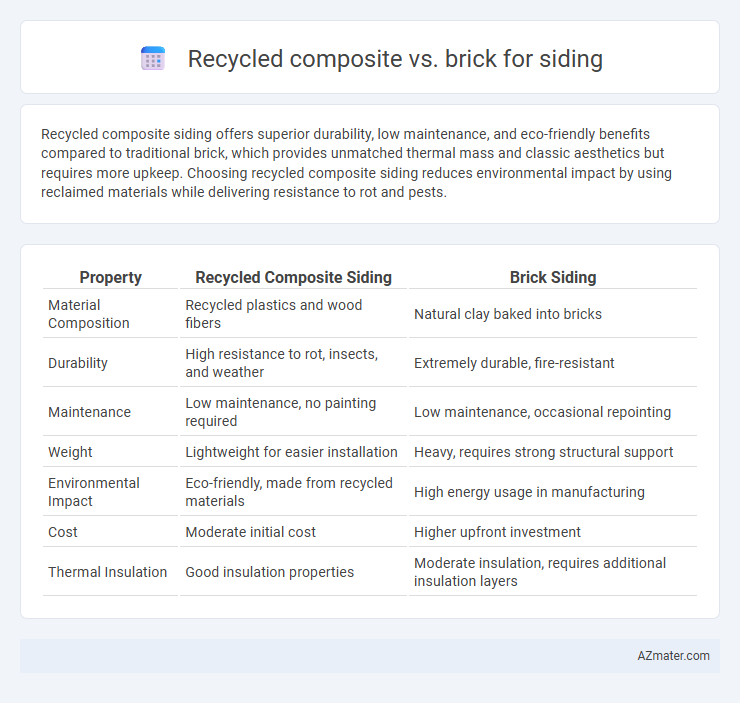Recycled composite siding offers superior durability, low maintenance, and eco-friendly benefits compared to traditional brick, which provides unmatched thermal mass and classic aesthetics but requires more upkeep. Choosing recycled composite siding reduces environmental impact by using reclaimed materials while delivering resistance to rot and pests.
Table of Comparison
| Property | Recycled Composite Siding | Brick Siding |
|---|---|---|
| Material Composition | Recycled plastics and wood fibers | Natural clay baked into bricks |
| Durability | High resistance to rot, insects, and weather | Extremely durable, fire-resistant |
| Maintenance | Low maintenance, no painting required | Low maintenance, occasional repointing |
| Weight | Lightweight for easier installation | Heavy, requires strong structural support |
| Environmental Impact | Eco-friendly, made from recycled materials | High energy usage in manufacturing |
| Cost | Moderate initial cost | Higher upfront investment |
| Thermal Insulation | Good insulation properties | Moderate insulation, requires additional insulation layers |
Introduction to Siding Materials
Recycled composite siding offers enhanced durability and eco-friendly benefits compared to traditional brick, making it a sustainable choice for modern constructions. Brick siding provides superior thermal mass and classic aesthetics but tends to be heavier and more labor-intensive to install. Both materials serve as effective weather barriers, with recycled composites delivering increased resistance to rot, pests, and fading.
Overview of Recycled Composite Siding
Recycled composite siding consists of a blend of post-consumer plastics and wood fibers, offering enhanced durability and resistance to rot, insects, and moisture compared to traditional brick. This siding requires less maintenance, eliminates the need for painting or sealing, and supports sustainable building practices by utilizing waste materials. Its lightweight nature simplifies installation and provides improved insulation properties relative to brick siding.
Traditional Brick Siding Explained
Traditional brick siding offers exceptional durability, fire resistance, and low maintenance, making it a popular choice for long-lasting home exteriors. Its natural thermal mass helps regulate indoor temperatures, enhancing energy efficiency and comfort. Unlike recycled composite siding, brick provides a timeless aesthetic and proven structural integrity that can increase property value over time.
Environmental Impact Comparison
Recycled composite siding significantly reduces landfill waste by repurposing materials such as plastic and wood fibers, lowering the demand for virgin resources compared to traditional brick production, which involves energy-intensive kiln-firing of clay. The carbon footprint of recycled composite siding is substantially lower, emitting fewer greenhouse gases during manufacturing and transportation due to its lighter weight. Brick, while durable and recyclable in some cases, typically requires more raw materials extraction and energy consumption, resulting in a larger environmental impact over its lifecycle.
Durability and Longevity
Recycled composite siding offers superior durability compared to traditional brick, resisting moisture, rot, and insect damage while requiring minimal maintenance over time. Brick, though highly durable and fire-resistant, can suffer from cracking and mortar deterioration, impacting its longevity in harsh climates. The lifespan of recycled composite siding typically exceeds 30 years, maintaining structural integrity and aesthetic appeal without frequent repairs.
Maintenance and Upkeep
Recycled composite siding requires minimal maintenance due to its resistance to rot, insects, and fading, needing only occasional cleaning with soap and water. Brick siding demands periodic mortar repointing and may require sealing to prevent moisture infiltration and efflorescence, increasing long-term upkeep efforts. Choosing recycled composite siding reduces time and expenses associated with routine upkeep while maintaining durability and aesthetic appeal.
Aesthetic and Design Options
Recycled composite siding offers a wide range of color palettes, textures, and finishes that mimic natural wood or stone, providing versatile and customizable design options compared to traditional brick, which typically comes in limited color variations and uniform textures. The ability of recycled composite materials to be molded into various shapes and sizes enables unique architectural styles and decorative elements, enhancing curb appeal. Brick siding, while classic and durable, often restricts homeowners to more conventional aesthetics and lacks the flexibility found in recycled composite alternatives.
Cost Analysis: Recycled Composite vs Brick
Recycled composite siding typically costs between $7 to $10 per square foot, offering an affordable alternative to brick, which ranges from $10 to $15 per square foot. Installation expenses for recycled composite are generally lower due to its lightweight nature, reducing labor costs compared to the heavier, labor-intensive brick installation. Long-term maintenance costs favor recycled composite as it resists rot and insect damage, while brick may require repointing and occasional repairs, impacting overall lifecycle expenses.
Installation Process and Challenges
Recycled composite siding offers a more straightforward installation process compared to traditional brick, featuring interlocking panels that reduce labor time and specialized masonry skills. Brick installation requires skilled masons to lay each unit with mortar, increasing project duration and potential for errors. Challenges with recycled composite include ensuring proper ventilation and expansion gaps, while brick faces issues like heavy material handling and longer curing times.
Choosing the Right Siding for Your Home
Recycled composite siding offers durability, resistance to moisture, and low maintenance, making it an eco-friendly choice for sustainable homes. Brick siding provides long-lasting strength, excellent insulation properties, and classic aesthetic appeal, ideal for traditional or Mediterranean-style exteriors. Evaluating factors such as climate, budget, maintenance preferences, and desired appearance helps homeowners choose the right siding material that enhances curb appeal and structural performance.

Infographic: Recycled composite vs Brick for Siding
 azmater.com
azmater.com